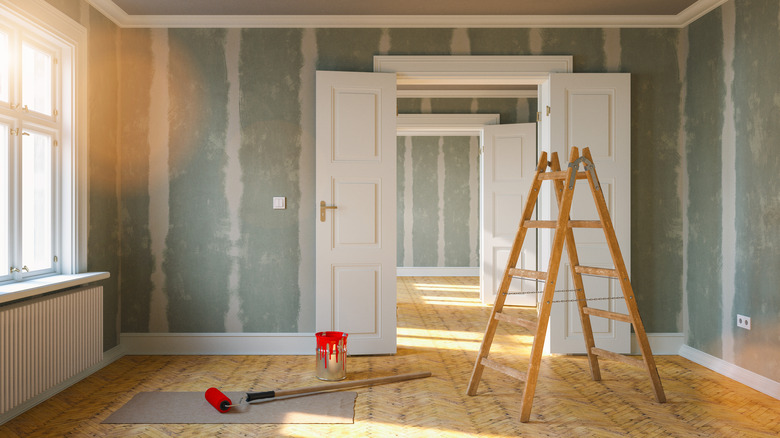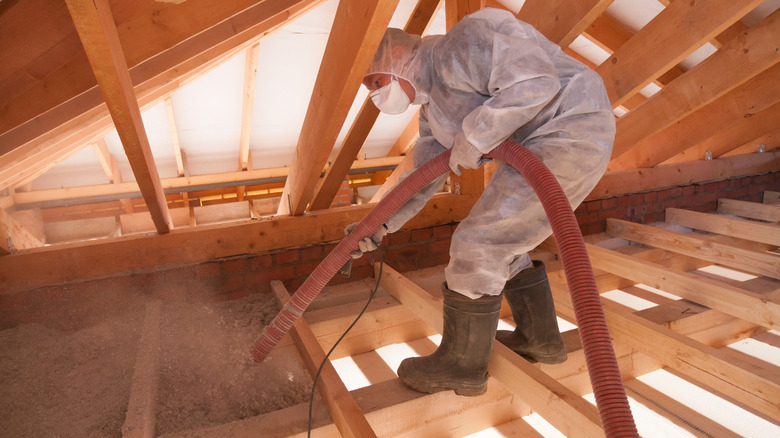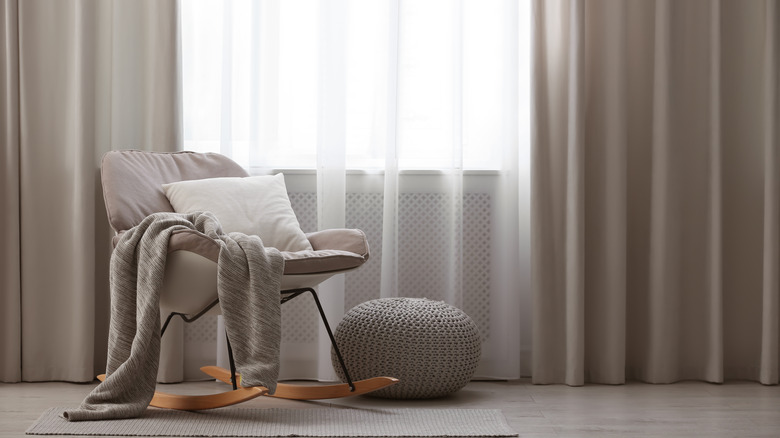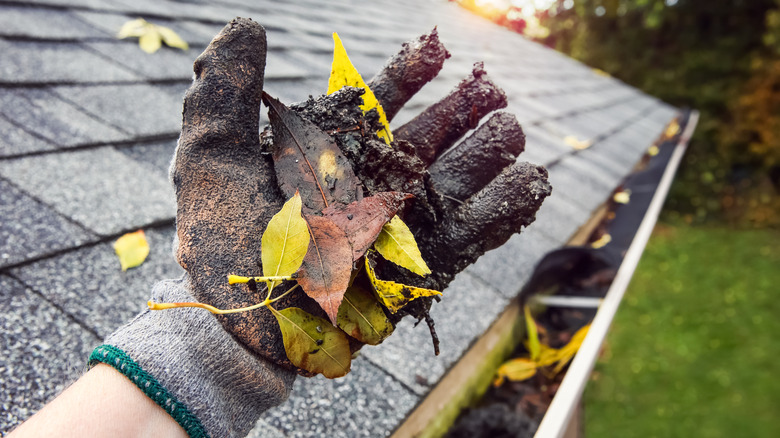Don't Forget To Do These Things Within Your First Year In A New Home
Congratulations on moving into your new home! You may have already completed the initial move-in tasks, such as unpacking, setting up utilities, updating your address, and doing a deep clean of your house or apartment. Other important tasks to complete upon moving into a new home are changing the batteries in smoke detectors, switching out the locks on your doors, and taking pictures of your belongings in the case of a burglary or natural disaster (via Apartment Therapy).
Moving into a new home can be stressful, which is why you may want to consider making a to-do list of everything you'll need to get done week by week or even month by month. The move-in tasks may vary depending on season, and you may not get to some of those lower-priority chores until months after moving in. It is important to stay organized so as not to forget what needs to be done over the course of the first year after moving in. If you're having trouble figuring out what you should do within the first year of moving into a new home or need some ideas to add to your list, check out the following suggestions.
Slap on a fresh coat of paint
Even if you're not looking to get deep into home renovation projects, one of the easiest and most cost-effective things you can do to spruce up your home and make it feel like your own is applying a fresh coat of paint to the interior and exterior walls. Most people think they should paint their home before moving in, but Toronto designer Judith Taylor says this is a mistake (per Apartment Therapy). Painting should wait until after you're moved in and have all your furniture and decorations in their places. This might mean a bit of extra work for you, but Taylor says it'll pay off because of the wide variety of shades and tones that paint comes in. You're more likely to be satisfied by the color you choose if you're certain it matches your upholstery, artwork, rug, and other items.
Painting the exterior of your home is another task that shouldn't be rushed, nor is it necessary to get done before or shortly after moving in. If you plan to paint at some point during the first year, you will have adequate time to choose a color and prepare your house for painting while not allowing so much time to pass that you get too busy with other things and let it fall by the wayside. Playing with accents and contrasting materials is a fun way to let your house stand out and give it character, according to Mosby Building Arts.
Don't forget your yard!
Landscaping can be a daunting and costly task, which is why it's nice to hold off until later within the first year after you move into your new home, especially if you move during the off-season or winter months. Regardless of the size of your yard, there are numerous ways you can give it a makeover to reflect your tastes and give your property some extra curb appeal. According to Love the Garden, you'll want to start by assessing your garden for various months, and ideally the first year, after moving in. The needs of your yard will change depending on the season and this will influence the choices you make when it comes to landscaping. For example, you might discover that the sunny corner of your yard actually becomes completely waterlogged after a big rainstorm or is hit hard by frost in the winter. This knowledge can save you time and money as you invest in your yard.
Other tasks that you may need to tackle before getting to the fun part of planting and designing your yard are pruning and cutting back hedges, weeding, and leveling your lawn. If your yard is too much work for you and your family to handle, consider researching reputable garden designers and landscaping companies that can come in and build you the yard of your dreams.
Ensure your insulation is up-to-date
Regardless of the season, proper housing insulation is incredibly important for regulating temperatures in your home year-round and making your home energy efficient, ensuring you save money on healing and cooling. Insulation has numerous other benefits, including keeping surface temperatures above dew point and preventing mold and mildew growth, reducing greenhouse gas emissions from your home, protecting against fires, and improving the return on investment of your home (via National Insulation Association). Just by adding insulation to the attic, crawl spaces, and basement, you will save an average of 15% on cooling and heating your home, and 11% on total energy costs, as noted by Energy Star. That's a significant amount of savings, adding up to roughly $200 per year.
Within the first year of moving in, you'll want to inspect your home's insulation and make sure it is properly installed and that the materials are up-to-date. The most common insulation materials are fiberglass, cellulose, and foam, but you'll also find mineral wool, denim, and natural fibers, such as cotton, straw, and hemp (per The Home Depot). You will likely see these materials in a variety of forms, including foam board, spray foam, batts, rolls, loose foam, and radiant barriers. The insulation you choose will depend on your budget and the needs of your home.
Dress up (or down) your space with window treatments
One of the last tasks that you'll likely do when decorating your home is deciding how to style and cover your windows. This is a great activity to get done after you've moved in all of your belongings and have applied a fresh coat of paint to your walls as it will complete the space and set the tone for how sophisticated or casual the room is. The four types of window treatments you'll choose from are drapes, blinds, curtains, and shades.
According to Seattle-based interior designer LeeAnn Baker, window treatments are like the icing on the cake (per House Beautiful). "When we're starting the design of a room, we're really stepping back and looking at it as a whole and thinking about what it will take to create a unified vision for it; window coverings play a big role in a room's unity," she explains. Baker also notes that consistency is key to making a home look perfect, including using similar treatments throughout the home instead of a opting for a different style in each room. The color scheme is also important as it should complement the overall feel and look of the space. Baker recommends that sheer fabrics be used to add layers and allow light to enter a room without overwhelming the space. Finally, floor-length curtains should be avoided in the kitchen as they give off a more formal, instead of functional, vibe.
Keep up with seasonal maintenance
Throughout the first year of living in your new home, you'll likely pass through several seasons. Each season requires different maintenance tasks to ensure proper house upkeep. Regularly checking on the systems in your home will prevent breakdowns and save money in the long run. At the beginning and end of each season, you'll want to verify that your appliances, electrical system, plumbing, security, and heating and cooling systems are all functioning properly (via Better Home & Gardens). Basic things to do across all seasons are checking that indoor and outdoor vents aren't blocked, cleaning the garbage disposal, testing smoke alarms and carbon monoxide detectors, inspecting electrical cords, and unclogging drains.
In the winter, you'll want to clean the furnace filter and flush out hot water from the water heater to get rid of debris. In the fall, make sure you check your fireplace(s) for damage and clean all flues, seal cracks in doors and windows, winterize exterior plumbing, remove leaves and other debris from gutters, and drain in-ground sprinkler systems. When spring rolls around, inspect your roof for damage, change the air-conditioner filter and have the system serviced, fertilize your lawn, and power wash windows and sidings. In the summer, check your dishwasher, kitchen, and bathroom cabinets for leaks, seal all tile grout, prune shrubs and trees, and clean your kitchen exhaust filter. If you come across any major repairs, it's a good idea to call in a professional as soon as you can.





